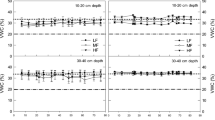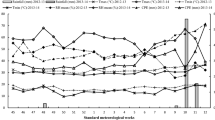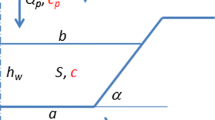Abstract
The objective of the present research was to explore the effects of combined irrigation and fertilization (fertigation) frequency on growth, yield and uptake of water and nutritional elements by plants. Lettuce (Lactuca sativa L., cv. Iceberg) was used as the model plant. Two experiments were conducted in a screen-house: compound fertilizer at a constant N:P:K ratio at different concentrations was used in the first, while in the second the concentration of P varied solely while the concentration of the other nutritional elements was kept constant. The lettuce was planted in pots filled with perlite and irrigated daily with a constant volume of nutrient solution at different frequencies. The major finding in the two experiments was that high fertigation frequency induced a significant increase in yield, mainly at low nutrients concentration level. Yield improvement was primarily related to enhancement of nutrient uptake, especially P. It was suggested that the yield reduction obtained at low frequency resulted from nutrient deficiency, rather than water shortage, and that high irrigation frequency can compensate for nutrient deficiency. Frequent fertigation improved the uptake of nutrients through two main mechanisms: continuous replenishment of nutrients in the depletion zone at the vicinity of root interface and enhanced transport of dissolved nutrients by mass flow, due to the higher averaged water content in the medium. As such, an increase in fertigation frequency enables to reduce the concentrations of immobile elements such as P, K and trace metals in irrigation water, and to lessen the environment pollution by discharge.
Similar content being viewed by others
References
Barber S A 1995 Soil Nutrient Bioavailability. Wiley, New York.
Bar-Yosef B 1999 Advances in fertigation. Adv. Agron. 65, 1–79.
Bures S, Marfa O, Perez T, Tebar J A and Lloret A 1997 Measure of substrates unsaturated hydraulic conductivity. Acta Hort. 450, 297–304.
Campbell G S and Turner N C 1990 Plant-soil-water relationship. In Management of Farm Irrigation Systems, Eds. G J Hoffman, T A Howell and K H Solomon. pp. 15–29. Amer. Soc. Agric. Eng. MI.
Claassen N and Steingrobe B 1999 Mechanistic simulation models for a better understanding of nutrient uptake from soil. In Mineral Nutrition of Crops, Fundamental Mechanisms and Implications. Ed. Z. Rengel. pp. 327–367. Haworth Press, New York.
da Silva F F, Wallach R and Chen Y 1993 Hydraulic properties of sphagnum peat moss and tuff (scoria) and their potential effects on water availability. Plant Soil 154, 119–126.
Jungk A O 1996 Dynamics of nutrient movement at the soil-root interface. In Plant Roots-the Hidden Half. 2nd edition. Eds. Y Waisel, A Eshel and U Kafkafi. pp. 529–556. Marcel Dekker, Inc. New York.
Marschner 1995 Minimal Nutrition of Higher Plants. 2nd Ed. Academic Press, New York.
Mmolawa K and Or D 2000 Root zone solute dynamics under drip irrigation: a review. Plant Soil 222, 163–190.
Nye P H and Tinker P B 1977 Solute Movement in the Soil-Root System. Blackwell Science Publishers, Oxford.
Orozco R and Marfa O 1995 Granulometric alteration, air entry potential and hydraulic conductivity in perlites used in soilless cultures. Acta Hort. 408, 147–161.
Raviv M, Wallach R, Silber A, Medina Sh and Krasnovsky A 1999 The effect of hydraulic characteristics of volcanic materials on yield of roses grown in soilless culture. J. Am. Soc. Hort. Sci. 124, 205–209.
SAS Institute Inc. 1995 JMP User's Guide, Version 3.1. SAS Institute Inc., Cary, NC.
Shalhevet J, Mantell A, Bielorai H, and Shimshi D 1981 Irrigation of field and orchard crops under semi-arid conditions. IIIC Publication No. 1, Bet Dagan, Israel.
Schecher W and McAvoy D C 1998 MINEQL+: A Chemical Equilibrium Modeling System, Version 4.0 for Windows, Environ. Res. Software, Hallowell, ME.
Steingrobe B and Scenk M K 1994 A model relating the maximum nitrate inflow of lettuce (Lactuca stavia L.) to the growth of roots and shoots. Plant Soil 162, 249–257.
Wallach R, da Silva F F and Chen Y 1992 Hydraulic characteristics of tuff (scoria) used as a container medium. J. Am. Soc. Hort. Sci. 117, 415–421.
Author information
Authors and Affiliations
Corresponding author
Rights and permissions
About this article
Cite this article
Silber, A., Xu, G., Levkovitch, I. et al. High fertigation frequency: the effects on uptake of nutrients, water and plant growth. Plant and Soil 253, 467–477 (2003). https://doi.org/10.1023/A:1024857814743
Issue Date:
DOI: https://doi.org/10.1023/A:1024857814743




